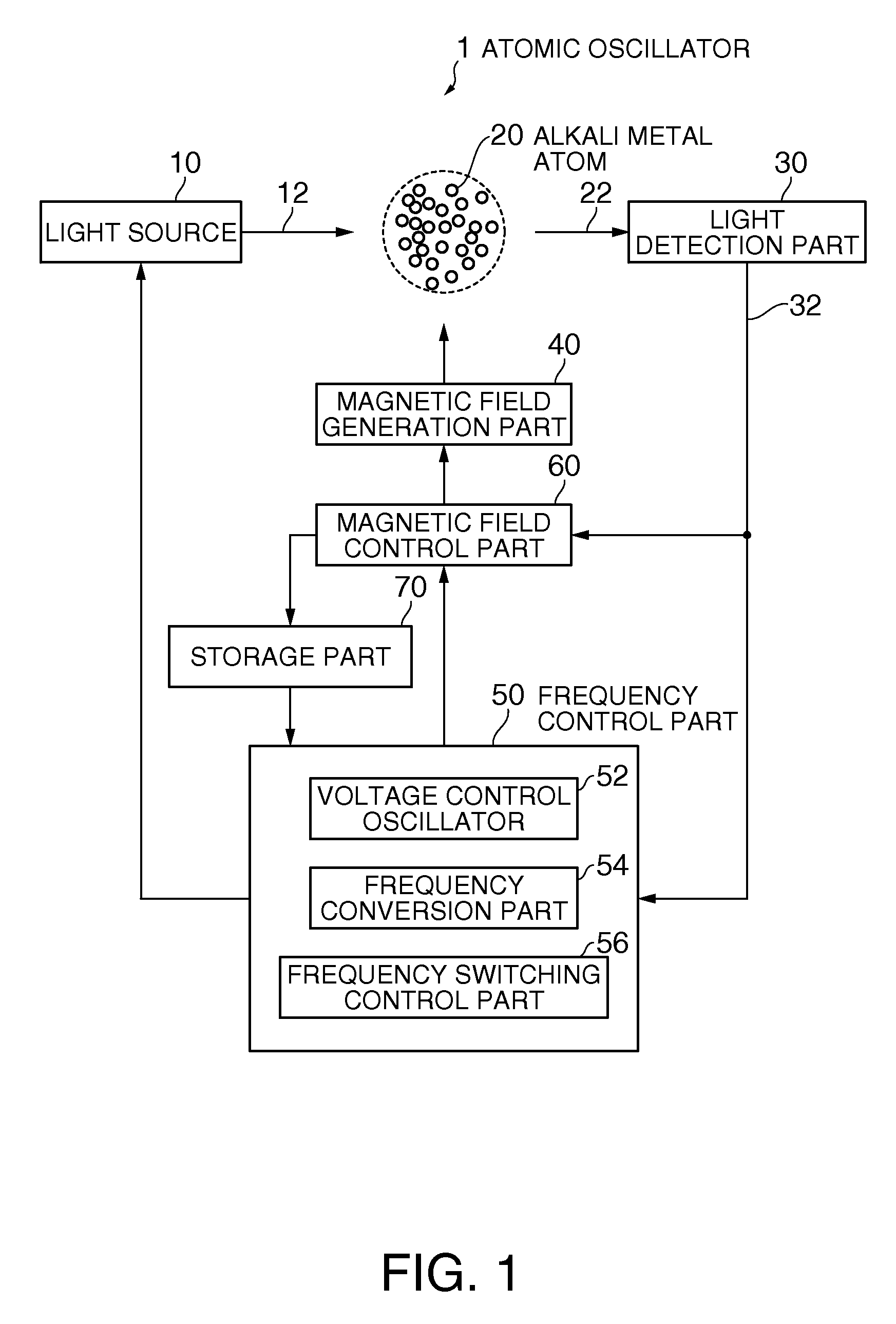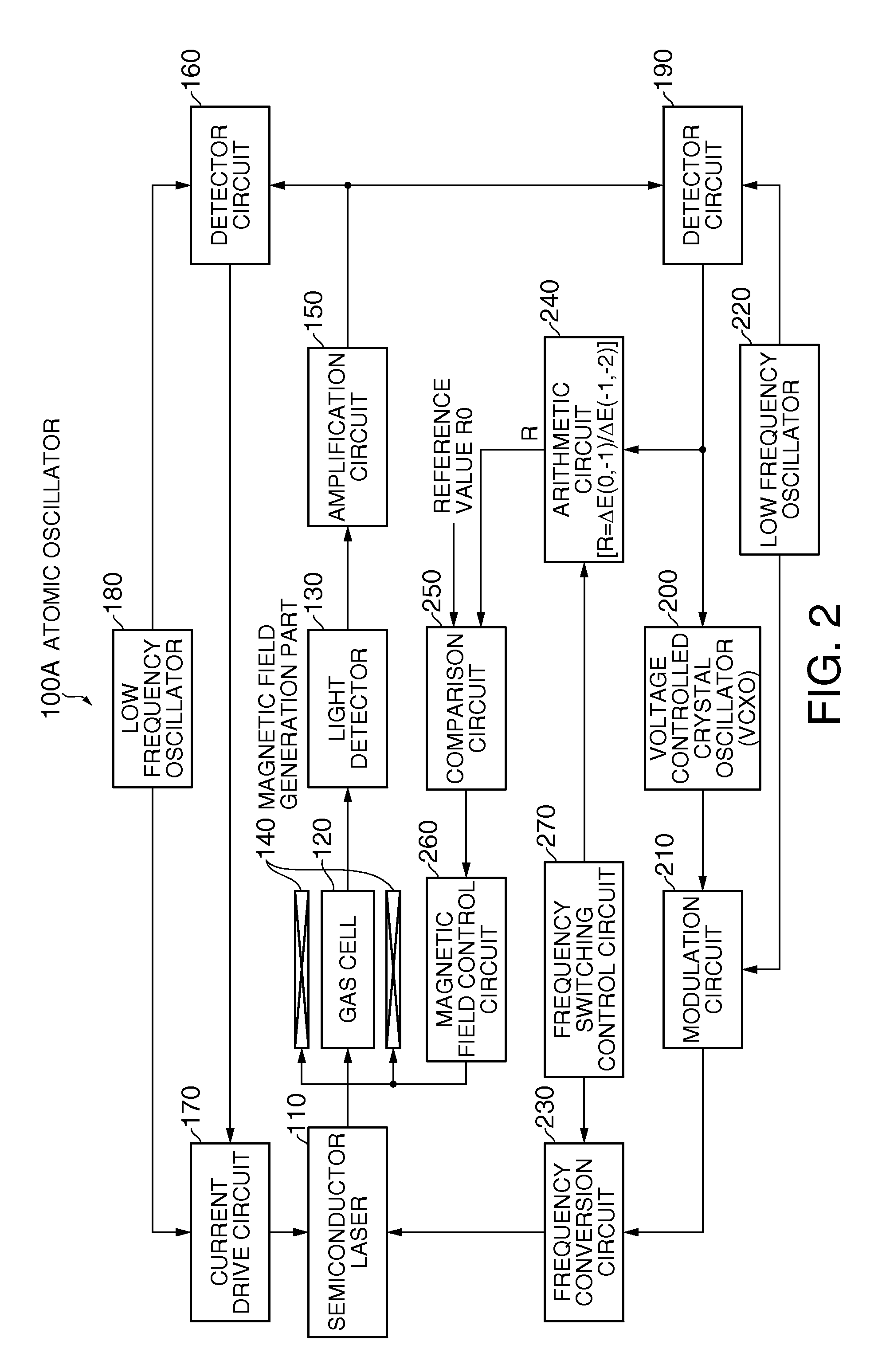Atomic oscillator
a technology of atomic oscillators and oscillators, which is applied in the direction of oscillator generators, pulse automatic control, masers, etc., can solve the problems of difficult to completely eliminate the influence of magnetic field, difficult to accurately detect peak values, and deterioration of frequency accuracy, so as to shorten the adjustment period of magnetic field, improve frequency stability, and delicate magnetic field control
- Summary
- Abstract
- Description
- Claims
- Application Information
AI Technical Summary
Benefits of technology
Problems solved by technology
Method used
Image
Examples
first embodiment
(1) First Embodiment
[0053]FIG. 2 is a view showing a structure of an atomic oscillator of a first embodiment.
[0054]As shown in FIG. 2, an atomic oscillator 100A of the first embodiment includes a semiconductor laser 110, a gas cell 120, a light detector 130, a magnetic field generation part 140, an amplification circuit 150, a detector circuit 160, a current drive circuit 170, a low frequency oscillator 180, a detector circuit 190, a voltage controlled crystal oscillator (VCXO) 200, a modulation circuit 210, a low frequency oscillator 220, a frequency conversion circuit 230, an arithmetic circuit 240, a comparison circuit 250, a magnetic field control circuit 260 and a frequency switching control circuit 270.
[0055]The semiconductor laser 110 generates plural lights different in frequency from each other and irradiates the lights to the gas cell 120. Specifically, control is performed by a drive current outputted by the current drive circuit 170 so that the center wavelength λ0 (cent...
second embodiment
(2) Second Embodiment
[0095]FIG. 11 is a view showing a relation between magnetic flux and ΔE(−1,−2), ΔE(0,−1), ΔE(+1,0) when frequency f12(0,0), f12(−1,−1), f12(−2,−2) corresponding to ΔE12 for each of (m,m′) =(0,0), (−1,−1) and (−2,−2) is in the relation of FIG. 5. In FIG. 11, the lateral axis indicates the magnetic flux density, and the vertical axis indicates the magnitude of the energy. Besides, ΔE(−1,−2), ΔE(0,−1) and ΔE(+1,0) are respectively indicated by a solid line, a broken line and an alternate long and short dash line.
[0096]As shown in FIG. 11, all of ΔE(−1,−2), ΔE(0,−1) and ΔE(+1,0) monotonically increase with respect to the magnetic flux density. Accordingly, when the intensity of the magnetic field is uniquely determined for anyone of ΔE(−1,−2), ΔE(0,−1) and ΔE(+1,0). That is, when any one of ΔE(−1,−2), ΔE(0,−1) and ΔE(+1,0) is obtained at a specified time, since the intensity of the magnetic field at that time is known, feedback control can be performed so that the i...
third embodiment
(3) Third Embodiment
[0114]In the atomic oscillator 100A of the first embodiment, the frequency conversion rate of the frequency conversion circuit 230 is switched at the constant timing irrespective of the state of the present magnetic field, and the adjustment of the magnetic field intensity is performed at the constant period. On the other hand, in the third embodiment, the timing when the frequency conversion rate of the frequency conversion circuit 230 is switched is changed according to the state of the magnetic field. Specifically, the adjustment period of the magnetic field intensity is changed according to the change of the magnetic field intensity.
[0115]FIG. 13 is a view showing a structure of an atomic oscillator of the third embodiment. In FIG. 13, the same structure as that of FIG. 2 is denoted by the same reference numeral, and its description is omitted or simplified.
[0116]As shown in FIG. 13, in an atomic oscillator 100D of the third embodiment, a history information ...
PUM
 Login to View More
Login to View More Abstract
Description
Claims
Application Information
 Login to View More
Login to View More - R&D
- Intellectual Property
- Life Sciences
- Materials
- Tech Scout
- Unparalleled Data Quality
- Higher Quality Content
- 60% Fewer Hallucinations
Browse by: Latest US Patents, China's latest patents, Technical Efficacy Thesaurus, Application Domain, Technology Topic, Popular Technical Reports.
© 2025 PatSnap. All rights reserved.Legal|Privacy policy|Modern Slavery Act Transparency Statement|Sitemap|About US| Contact US: help@patsnap.com



